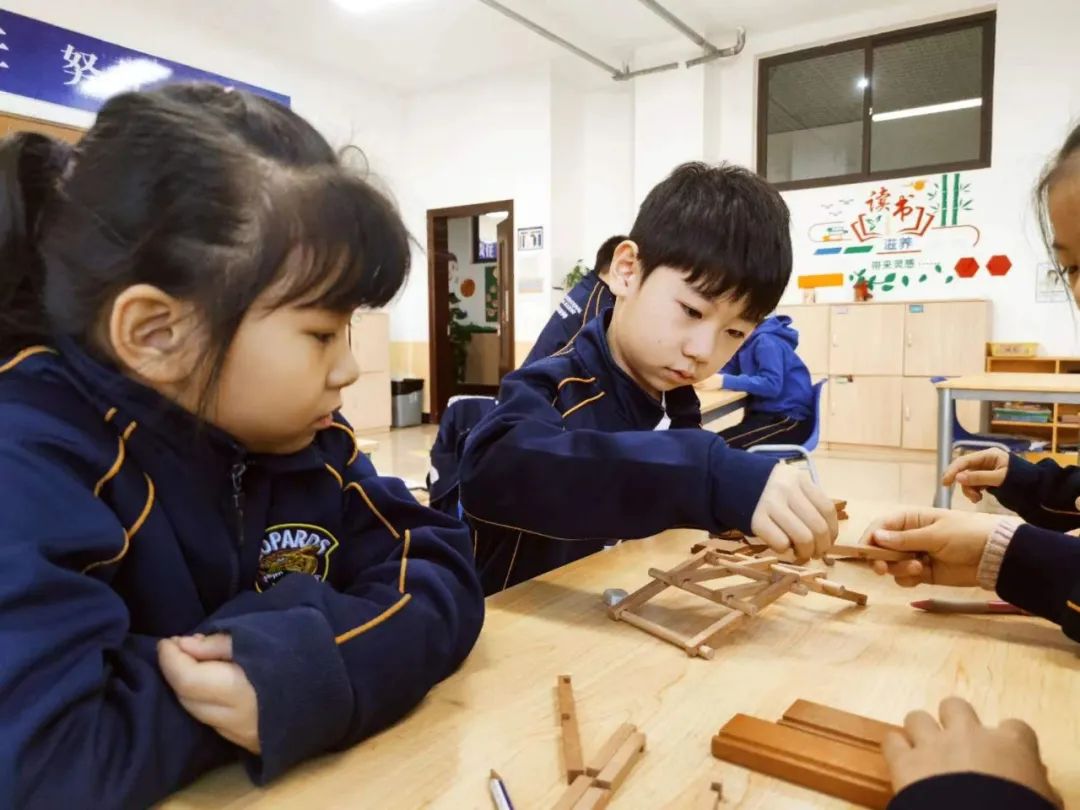2024-06-05发布于天津
数学不仅仅是数字,更是解开宇宙奥秘的钥匙。
在天津海嘉,我们的双语数学课程为您打开了一个栩栩如生、方程舞动的奇妙世界!
在充满活力的双语数学环境,专业且经验丰富的教师致力于帮助学生构建好底层数学逻辑,打好数学基础并通过创新的国际教学方法,培养学生的数学素养。
精心打造 | 双语数学教育
在数学课堂中,我们把中外数学教育的精髓相互融合,打造出了一套独特的双语教学体系。其中国家课程是基础,老师们会根据国家课程标准进行深度教研,从而保证数学教学的深度与国家课程要求一致。



多样参与 | 创新教学方法
双语教学的开展充满活力。在数学课堂中,我们根据不同学生的年龄、学习特点和认知能力采用多种教学方法,将国际化的数学教学真正落地到日常教学中,同时通过互动式学习,赋予学生在数学和双语方面的出色才能。



趣味融合| 数学思维探索
踏入我们的数学课堂,学习将是一场奇妙的探险。从中文授课到英文关键点强化,让学生从多个角度理解抽象的数学概念,培养更为深入的数学逻辑,同时磨练双语能力。
在课堂中,老师还会根据不同学生的特点和兴趣点选用适当的方式启发孩子的数学热情并让他们更好地融入到互动课堂。
✓针对视觉学习者,老师会为学生准备更多元的视觉影像及教具帮助学生理解更为抽象的学习概念。
✓ 针对言语型学习者,老师会鼓励学生通过课堂笔记,以文字或图画的形式及时地将在课堂中所学的内容进行总结。
✓针对动觉型学习者,老师将在课堂中找到适合他们的互动方式,融入适合其互动的环节让其更好得加深记忆。
✓针对社交型学习者,老师将更多地通过小组互动和合作进行同伴学习,互相进步和成长。
以认识人民币课题举例:
在学习认识人民币时,孩子基于之前的知识学习经验会发现人民币和“数”的学习具有一致性,人民币上的数字由数字和计数单位组成,并且他们都是通过“十进制”规则运行的。在拓展学习中,学校邀请了学生家长走进课堂,为我们分享外币知识,让孩子们认识到钱币不仅仅是货币,更是国家形象和文化底蕴的独特名片。




认识人民币,不能只停留在对纸币的观察,更要让小朋友们回归到实际场景之中。孩子们列好购物清单,在老师的陪同下,一起走进商店、超市,了解不同物品的定价,认真记录,仔细计算,结账,买单,找零。在过程中,孩子们不仅买到了心仪的物品,也体验并理解了“贵”和“便宜”,感受到了爸爸、妈妈辛苦挣钱不容易,更懂得实体货币的支付运用。


从这些课堂片段不难看出,在海嘉,数学学习不是高强度的反复强化,而是在激发兴趣的基础上帮助学生吃透原理,学会举一反三,让数学成为生活的一部分,让数学思维成为随时调用的工具——这就是我们的孩子这么喜欢数学课的背后逻辑。
ENGLISH VERSION
BIBA's holistic approach to teaching International Math integrates language learning with mathematical concepts in a cohesive and comprehensive manner. By blending Chinese mathematical principles with international standards, our curriculum offers a unique educational experience. We emphasize making learning fun and engaging through various interactive methods. We believe that hands-on experiences are crucial for enabling children to grasp math concepts effectively and retain them longer. This approach not only equips students with the confidence to master math concepts but also enhances their proficiency in both English and Chinese vocabulary. Through this integrated approach, students develop not only mathematical skills but also bilingual proficiency and a deeper understanding of cultural contexts.
Example Lesson: Fractions—Exploring Wholes, Halves, and Quarters

Objectives:
- To help the students identify and compare wholes, halves and quarters using bilingual vocabulary and hands-on activities.
- To enable students to solve fraction word problems with confidence and accuracy using illustrations
1. Introduction (Bilingual Vocabulary):
The lesson is begun by introducing the concept of fractions using bilingual vocabulary cards (English and Chinese). Visuals of objects divided into halves and quarters, such as pizzas or shapes, are displayed.
To ensure that math lessons are enjoyable and accessible to students of all language abilities, the terms "whole" ("整体" or "整" , "half" ("半" ), and "quarter" ("四分之一") are introduced in both languages, with emphasis on pronunciation and meaning. Throughout their Math lessons, students are supported and guided by our bilingual teacher assistants for the elementary grades 1 and 2..
At this stage, students are also introduced to how shapes can be divided into both equal and unequal parts, and they develop the ability to identify these divisions through interactive games.
2. Teaching Approach and Methodology:
Following the popular CRA (Concrete, Representational, Abstract) approach, our fraction lessons are carefully sequenced.

The Concrete Stage involves using tangible objects and manipulatives that they can physically interact with. This could include using playdough or clay to divide into halves or quarters.
In the Representational Stage, visuals and simple drawings help young children visualize fractions: As shown below we use digital tools or apps that simulate fraction manipulatives in a visually appealing format. The teacher demonstrates how to divide a shape into halves and quarters using these manipulatives. and moreover, encourage students to work in pairs or small groups to create their own shapes divided into halves and quarters using playdough or paper cutouts.
The Abstract Stage for these young learners focuses on introducing basic fraction symbols and concepts in a simplified manner: Therefore, the students are introduced with fraction symbols (e.g., ½ for half, ¼ for quarter) alongside concrete and representational activities.
3. Cultural Context (Integration):
At BIBA, cultural integration is valued across all subjects taught. This element enhances students’ learning experiences, fosters inclusivity, and prepares them to thrive in a multicultural society.
For instance, fractions in Chinese culture involve dividing traditional dishes like mooncakes or dumplings during festivals. Similarly, Italians have their own tradition of cutting pizzas in specific ways, and there's a cultural significance to why hamburgers are typically halved. Visual aids such as pictures or videos are used to illustrate these cultural practices effectively.

4.Real-world connection through word problems:
Word problems are an integral part of BIBA curriculum and are crucial for teaching fractions as they offer real-world applications,deepen contextual understanding, and foster critical thinking skills. By solving these problems, students integrate math with literacy, develop procedural fluency, and prepare for complex concepts, all while grasping fractions' practical relevance in daily life.Here’s an example:
Problem:Sarah has a pizza that is cut into 4 equal slices. She eats 2 slices. What fraction of the pizza did Sarah eat? What fraction of the pizza is left?
Solution:The pizza is divided into 4 equal slices, so each slice represents one-quarter (¼) of the pizza.
Sarah eats 2 slices:Each slice is ¼ of the pizza.Sarah eats 2 slices.Fraction of the pizza Sarah ate:2/4 or 1/2

5. Formative Assessments:
Students' understanding is assessed informally through observations and participation in activities. As an extension, they are challenged to create a bilingual poster that shows various objects divided into halves and quarters, with each fraction labeled in both English and Chinese.
6. Reflection and Closure:
All lessons are concluded with a bilingual reflection. The students are asked to share what they learned about fractions in both languages and how they can use fractions in daily life.
By integrating Chinese and English throughout the lesson, students not only learn mathematical concepts effectively but also enhance their bilingual proficiency and cultural awareness. This approach ensures that all students, regardless of language background, can engage deeply with fractions and develop a holistic understanding of mathematical principles in a multicultural context.

Our holistic approach to teaching math ensures every student not only learns core mathematical concepts but also develops critical thinking skills and practical problem-solving abilities. Through hands-on activities, real-world applications, and personalized support, we empower students to excel academically and confidently apply their math knowledge in various contexts. Our commitment to nurturing well-rounded learners prepared for future.

声明:本文内容为国际教育号作者发布,不代表国际教育网的观点和立场,本平台仅提供信息存储服务。
全国500所国际学校大全 / 3分钟匹配5-8所 / 1年名校升学备考托管服务



